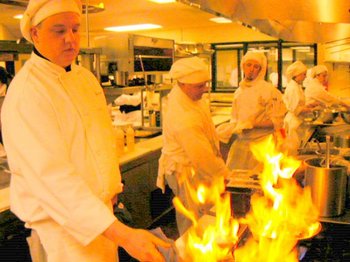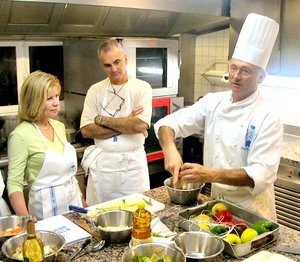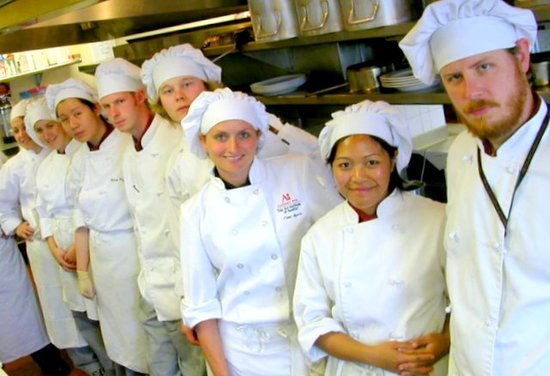Fourth quarter students at the Art Institute of Seattle; below right: Cordon Bleu master class in Paris, Kitchen Academy facilities in Kent.
Peter Lamb, a successful entrepreneur who has opened half a dozen Seattle restaurants, stands outside his latest, Belltown's Branzino. "I never hire cooks, I hire dishwashers, train them and promote them," he says. "A kid can come to work for me tomorrow as a dishwasher, and after two years, he's a $13 or $14 an hour line cook. That same kid, if he goes to culinary school, graduates two yeras later, $50,000 in debt, and he's lucky to get a job for $9 an hour."
They come from middle-class suburbs, from broken marriages, from minimum wage jobs, or straight out of high school. They come because they think it's glamorous to work in a professional kitchen, they come with the hope of a better life, because they dream of the Food Network, of being a Top Chef. Some sign up for the culinary programs at community colleges; many more enroll in expensive private academies, institutes and cooking schools.
Why? Because there's no formal apprenticeship system in this country for a trade like restaurant chef, where the traditional career path was to start at the restaurant's back door, in the dish pit. After a few months, if you kept showing up, you'd get moved up to busser, or to a prep station, earning your stripes by doing every dirty job. (Sadly, trust me, there are very few restaurants in this country with American dishwashers.) Most restaurants these days feed their staff, but few pay more than minimum wage, and a share of tips is iffy at best.
And still they come, like salmon smolt, despite the lousy odds, despite the astonishingly high price, akin to a year at Harvard. The primary reason, TV glamor aside: the ready availability of student loans for tuition.
* * *
Back in December, a for-profit school in Portland, the Western Culinary Institute, was the target of a lawsuit claiming, among other things, that graduates could not find work in the field after they had spent between $20,000 and $40,000 in tuition, or that they made no more money after attending the school than before. The case, which could cover as many as 2,000 former students, has been certified as a class action lawsuit and is working its way through the Oregon courts. It's a warning shot of skirmishes to come between the well-connected industry of for-profit schools and disillusioned students, which has now escalated to an all-out war between the federal government and Wall Street bankers.
 Here in Seattle, in a little-noticed development at the end of July, the American Federation of Teachers lost an election to represent the faculty at the Art Institute of Seattle. Teachers had complained that school was putting more emphasis on recruiting students than on teaching them properly. The high cost of tuition was another concern, the union said: an "associate degree" in photography or culinary arts costs close to $60,000; a bachelor's degree in fashion design costs over $80,000. Only the SeattlePI.com covered the issue. Although the school gave in to the faculty's request for updated computer equipment; the AFT blamed the unexpected outcome on aggressive union-busting by the Art Institute's parent company, Education Management Corporation.
Here in Seattle, in a little-noticed development at the end of July, the American Federation of Teachers lost an election to represent the faculty at the Art Institute of Seattle. Teachers had complained that school was putting more emphasis on recruiting students than on teaching them properly. The high cost of tuition was another concern, the union said: an "associate degree" in photography or culinary arts costs close to $60,000; a bachelor's degree in fashion design costs over $80,000. Only the SeattlePI.com covered the issue. Although the school gave in to the faculty's request for updated computer equipment; the AFT blamed the unexpected outcome on aggressive union-busting by the Art Institute's parent company, Education Management Corporation.
Turns out, EDMC's largest shareholder, holding 38 percent of its stock, is none other than Goldman Sachs, the Wall Street firm that recently agreed to pay $550 million to settle civil-fraud charges related to the subprime mortgage meltdown. According to Bloomberg News, Goldman Sachs is heavily invested in this controversial for-profit educaton industry, and now finds itself under attack not only from Congress and the Obama administration but from dissatisfied students as well.
Most students take out loans to pay for their tuition, resulting in high levels of debt. For the past couple of decades, student loan debt has been "guaranteed" by a variety of government agencies, just like mortgages, resulting in a wave of subprime loans that students won't ever be able to pay back. A fulltime restaurant cook (a rarity in a turbulent industry) is lucky to make $20,000 a year, which makes paying back $50,000 worth of student loans within 10 years of graduation virtually impossible. (The Art Institute's director of communications, Mark Livingston, declined Cornichon's request to comment for this post.)
An article in Bloomberg News explains further:
A proposed government crackdown may have a disproportionate effect on EDMC. The U.S. Department of Education may restrict taxpayer-funded grants and loans to for-profit colleges like EDMC that offer $50,000 associate's and $100,000 bachelor's degrees in such low-paying fields as cooking, art and design.
"Government grants and loans to students, combined with booming enrollment, have made for-profit colleges a rewarding investment," the article continues. According to Bloomberg and the Education Department, EDMC receives over 80 percent of its revenue from federal financial-aid programs, programs that prop up the entire for-profit college industry to the tune of over $25 billion a year.
 Nor is Goldman Sachs the only player. Career Education Corp. operates 80 for-profit campuses with 90,000 students around the US, including 18 schools licensed by Paris-based Le Cordon Bleu. Western in Portland is a CEC campus. Their Seattle area affiliate is the American Kitchen Academy in Kent, which charges about $20,000 for a diploma. Julia Child trained at the original Cordon Bleu in Paris, but the school has since been sold to culinary entrepreneur André Cointreau, who extended its agreement with CEC for five years in 2009 despite complaints that CEC was using deceptive practices to enroll students and misleading them about job prospects for graduates.
Nor is Goldman Sachs the only player. Career Education Corp. operates 80 for-profit campuses with 90,000 students around the US, including 18 schools licensed by Paris-based Le Cordon Bleu. Western in Portland is a CEC campus. Their Seattle area affiliate is the American Kitchen Academy in Kent, which charges about $20,000 for a diploma. Julia Child trained at the original Cordon Bleu in Paris, but the school has since been sold to culinary entrepreneur André Cointreau, who extended its agreement with CEC for five years in 2009 despite complaints that CEC was using deceptive practices to enroll students and misleading them about job prospects for graduates.
One notable exception is the prestigious Culinary Institute of America, a four-year professional college with a Hudson valley campus in New York and a Napa Valley campus in California. Tuition comes to about $30,000 a year (housing adds another $15,000), but CIA grads get snapped up by big-city restaurants that can afford to pay a living wage.
Community colleges, often derided as college-lite, also provide a respectable, well-rounded culinary education, and not just "knife skills." The programs at two of Seattle's community colleges, at the Central campus (called Seattle Culinary Academy) and at South Seattle, are particularly well regarded, primarily because their instructors have excellent reputations as chefs. South also has an excellent wine technology program. The biggest reason to attend a community college, however, is the probably the cost: between 10 and 20 percent of what the for-profit schools charge. A student who attends fulltime for seven quarters will earn an Associate of Applied Science degree at a cost of no more than $10,000. More students at community colleges stick with the entire program, too, while students at for-profit schools are more likely to quit. What's more, community college programs have a better reputation with restaurant managers, who are happy to hire graduates for entry-level positions.
And what of home cooks, who might only want to know the techniques of tenderizing pot roast or the mechanics of making meatloaf? Professional courses aside, there's no shortage of advice online, and plenty of recreational cooking classes around Seattle, offered by cookware shops such as Magnolia's Dish It Up, restaurants like La Mondellina and independent cooking schools like the Blue Ribbon Culinary Center on Lake Union. The cost of a class is usually between $60 and $100, often includes wine, and is more like a night at a restaurant than a master class; the difference being that there's no pretense of a professional credential.
The point is not that the Art Institute's culinary program is substandard. Far from it. The staff and instructors work hard; the program is accredited by the American Culinary Federation; several of its graduates have gone on to fame and fortune. But many more drop out, unprepared for the rigors of independent study. The casualty count is high, but the admissions office, like military recruiters, are relentless in their pursuit of ever more cannon fodder.
Restaurant life is a culture apart, with a swagger like the Marines, and it helps a lot if you don't do drugs and speak a little Spanish. If you seriously want to get into the restaurant business, and if you realize that your chances of starring on Iron Chef are about the same as being named MVP of the Superbowl, then just start working in restaurants. Dishwasher or busser, yes. Minimum wage, yes. School? A very big maybe. "Community college, for the theory and the math" suggests an industry veteran, "but keep your nighttime job in the kitchen."


I am graduating this Dec. 2010. - B.S. in Culinary Management, from the Art Inst. of Washington. I feel that you are speaking for me. The majority of the students at AIW feel the same way. We are frustrated because our issues are being swept under the rug. My son went to the CCA in SFO run by Le Cordon Bleu. They did not do anything for him and he can't find a decent job that pays well enough to help him pay for his student loan.